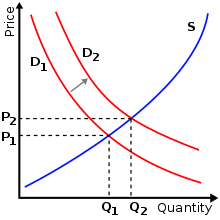Microeconomics (from Greek prefix mikro- meaning "small") is a branch of economics that studies the behavior of individuals and firms in making decisions regarding the allocation of scarce resources and the interactions among these individuals and firms.
One goal of microeconomics is to analyze the market mechanisms that establish relative prices among goods and services and allocate limited resources among alternative uses. Microeconomics shows conditions under which free markets lead to desirable allocations. It also analyzes market failure, where markets fail to produce efficient results.
Microeconomics stands in contrast to macroeconomics, which involves "the sum total of economic activity, dealing with the issues of growth, inflation, and unemployment and with national policies relating to these issues".Microeconomics also deals with the effects of economic policies (such as changing taxation levels) on the aforementioned aspects of the economy.Particularly in the wake of the Lucas critique, much of modern macroeconomic theory has been built upon 'microfoundations'—i.e. based upon basic assumptions about micro-level behavior.
Assumptions and definitions
Microeconomic theory typically begins with the study of a single rational and utility maximizing individual. To economists, rationality means an individual possesses stable preferences that are both complete and transitive. The technical assumption that preference relations are continuous is needed to ensure the existence of a utility function. Although microeconomic theory can continue without this assumption, it would make comparative statics impossible since there is no guarantee that the resulting utility function would be differentiable.
Microeconomic theory progresses by defining a competitive budget set which is a subset of the consumption set. It is at this point that economists make the technical assumption that preferences are locally non-satiated. Without the assumption of LNS (local non-satiation) there is no guarantee that a rational individual would maximize utility. With the necessary tools and assumptions in place the utility maximization problem (UMP) is developed.
The utility maximization problem is the heart of consumer theory. The utility maximization problem attempts to explain the action axiom by imposing rationality axioms on consumer preferences and then mathematically modeling and analyzing the consequences. The utility maximization problem serves not only as the mathematical foundation of consumer theory but as a metaphysical explanation of it as well. That is, the utility maximization problem is used by economists to not only explain what or how individuals make choices but why individuals make choices as well.
The utility maximization problem is a constrained optimization problem in which an individual seeks to maximize utility subject to a budget constraint. Economists use the extreme value theorem to guarantee that a solution to the utility maximization problem exists. That is, since the budget constraint is both bounded and closed, a solution to the utility maximization problem exists. Economists call the solution to the utility maximization problem a Walrasian demand function or correspondence.
The utility maximization problem has so far been developed by taking consumer tastes (i.e. consumer utility) as the primitive. However, an alternative way to develop microeconomic theory is by taking consumer choice as the primitive. This model of microeconomic theory is referred to as Revealed preference theory.
The theory of supply and demand usually assumes that markets are perfectly competitive. This implies that there are many buyers and sellers in the market and none of them have the capacity to significantly influence prices of goods and services. In many real-life transactions, the assumption fails because some individual buyers or sellers have the ability to influence prices. Quite often, a sophisticated analysis is required to understand the demand-supply equation of a good model. However, the theory works well in situations meeting these assumptions.
Mainstream economics does not assume a priori that markets are preferable to other forms of social organization. In fact, much analysis is devoted to cases where market failures lead to resource allocation that is suboptimal and creates deadweight loss. A classic example of suboptimal resource allocation is that of a public good. In such cases, economists may attempt to find policies that avoid waste, either directly by government control, indirectly by regulation that induces market participants to act in a manner consistent with optimal welfare, or by creating "missing markets" to enable efficient trading where none had previously existed.
This is studied in the field of collective action and public choice theory. "Optimal welfare" usually takes on a Paretian norm, which is a mathematical application of the Kaldor–Hicks method. This can diverge from the Utilitarian goal of maximizing utility because it does not consider the distribution of goods between people. Market failure in positive economics (microeconomics) is limited in implications without mixing the belief of the economist and their theory.
The demand for various commodities by individuals is generally thought of as the outcome of a utility-maximizing process, with each individual trying to maximize their own utility under a budget constraint and a given consumption set.





0 comments:
Post a Comment